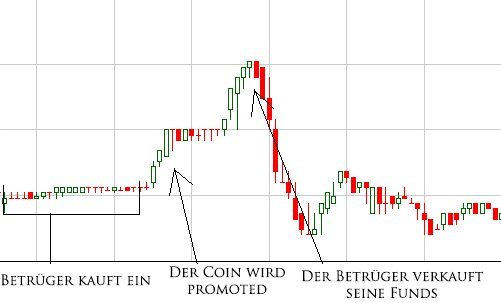The so-called "pump-and-dump" (PnD) is a fraud scheme from the field of stock and securities trading, but it has also become very popular with fraudsters in the field of cryptocurrencies in recent years. Although many of these "pump-and-dumps" are planned and even publicly announced on social media channels, there are many people who do not have this information and become victims of fraud. Since the cryptocurrency market is still largely unregulated and a relatively small and closed community, conducting a PnD is particularly easy.
In a PnD scheme, the price of a cryptocurrency is artificially inflated ("pumped") by false, misleading or exaggerated information about the price of the coin/token. The fraudster can profit from the price inflation by quickly selling his previously cheaply acquired funds at a high price ("dumping").
At the same time, the new owner of the coins is likely to lose a significant part of their capital, as the price of the corresponding cryptocurrency will usually fall very quickly.
In regular and regulated securities markets, this procedure is highly illegal. The crypto market, on the other hand, is unfortunately still largely "Wild West" when it comes to such practices. So extreme caution is required!
The system often involves the manipulation of cryptocurrencies that do not have a large community and only a very low market capitalization. Therefore, the information about the coins/tokens can be easily manipulated by the fraudsters. The lack of public information also creates favorable conditions for fraudsters, as potential investors do not have enough sources to verify all available information about the project in question.
Furthermore, these "microcap" coins are highly illiquid with extremely low trading volumes. Therefore, even relatively small transactions can drive up the price of the security considerably, which makes the fraudsters' "job" much easier.
John McAfee, the British-American entrepreneur and developer of a well-known antivirus software, gained notoriety in the cryptospace in the late fall of 2017 with regard to pump-and-dump schemes.
He was paid by small and unknown projects to use his reach - and still relatively good reputation to date - to promote their coin or token on Twitter and his other social channels as the "next big thing" or "Bitcoin killer". In most cases, he also made direct purchase recommendations for the corresponding cryptocurrencies, thus enticing people to "pump" the useless coins. He himself and the issuers of the coins had of course already stocked up cheaply beforehand and were therefore able to "dump" in good time.

The fear of missing out on potential profits [=fear of missing out (fomo)] is particularly prevalent among beginners and newcomers to cryptocurrencies. Unfortunately, it is precisely this FOMO that tempts people to fall victim to pump-and-dump systems.
If a beginner sees a coin that has risen by 100% or more in a very short space of time, it is only natural to want to share in the profits. Unfortunately, investing at such a time is usually the wrong decision, as a longer "pump" phase is often followed by a quick "dump" phase. Newcomers generally don't pay attention to indicators such as the level of trading volume etc., which is why there are always people who fall for such scams.
Are you also new to cryptocurrencies, interested in a project or its coin and afraid of succumbing to a pump-and-dump system? Join our free Blocktrainer forum and get advice from the community.